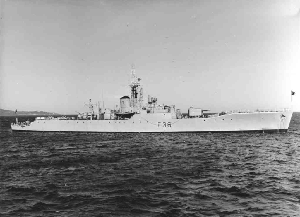HMS Whitby (F36)

| |
| History | |
|---|---|
| Name | HMS Whitby |
| Ordered | 2 February 1951 |
| Builder | Cammell Laird and Co Ltd, Birkenhead |
| Laid down | 30 September 1952 |
| Launched | 2 July 1954 |
| Commissioned | 10 July 1956 |
| Decommissioned | 1974 |
| Identification | Pennant number: F36 |
| Fate | Sold for scrapping in 1979 |
| General characteristics | |
| Class and type | Whitby-class frigate |
| Displacement | |
| Length | |
| Beam | 41 ft (12.5 m) |
| Draught | 17 ft (5.18 m) |
| Propulsion | Y-100 plant; 2 Babcock & Wilcox boilers, 2 English Electric steam turbines, 2 shafts, 30,000 shp (22 MW) |
| Speed | 30 kn (56 km/h) |
| Range | 370 tons oil fuel, 4,200 nmi (7,780 km) at 12 knots (22 km/h) |
| Complement | 152, later 225 |
| Sensors and processing systems |
|
| Armament |
|
HMS Whitby was a Whitby-class or Type 12 anti-submarine frigate of the Royal Navy of the United Kingdom built by Cammell Laird and Co Ltd, Birkenhead. She was launched on 2 July 1954 and commissioned on 10 July 1956.
Design[edit]
The Whitby-class was designed as a class of specialist anti-submarine warships, intended to counter fast modern diesel-electric submarines. As such, the design was required to reach a speed of at least 27 knots (31 mph; 50 km/h), maintaining high speed in rough weather conditions and have a range of 4,500 nautical miles (5,200 mi; 8,300 km) at 12 knots (14 mph; 22 km/h). To meet these requirements, the Type 12s had a new hull form and, unlike the contemporary Type 41 anti-aircraft and Type 61 air direction frigates, were powered by steam turbines.[1][2]
Whitby was 370 feet 0 inches (112.78 m) long overall and 360 feet 0 inches (109.73 m) at the waterline, with a beam of 41 feet 0 inches (12.50 m) and a draught of 11 feet 0 inches (3.35 m) forward and 13 feet 0 inches (3.96 m) at the propellers.[3] The ships were powered by the new Y-100 machinery in which the ship's boilers and steam turbines were designed as a closely integrated set of machinery to increase efficiency. Two Babcock & Wilcox water-tube boilers fed steam at 550 pounds per square inch (3,800 kPa) and 850 °F (454 °C) to two sets of geared steam turbines which drove two propeller shafts, fitted with large (2 feet (0.61 m) diameter) slow-turning propellers. The machinery was rated at 30,000 shaft horsepower (22,000 kW), giving a speed of 29 knots (33 mph; 54 km/h).[4][5] Crew was about 189 when operated as a leader and 152 as an ordinary ship.[6]
A twin 4.5-inch (113 mm) Mark 6 gun mount was fitted forward, with 350 rounds of ammunition carried, with close-in armament of a stabilised STAAG (Stabilised Tachymetric Anti-Aircraft Gun) twin Bofors 40 mm L/60 gun mount aft.[7] The design anti-submarine armament consisted of twelve 21-inch torpedo-tubes (eight fixed and two twin rotating mounts) for Mark 20E Bidder homing anti-submarine torpedoes, backed up by two Limbo anti-submarine mortars fitted aft. The Bidder homing torpedoes proved unsuccessful however, being too slow to catch modern submarines, and the torpedo tubes were soon removed.[8]
The ship was fitted with a Type 293Q surface/air search radar on the foremast, with a Type 277 height-finding radar on a short mast forward of the foremast. A Mark 6M fire control system (including a Type 275 radar) for the 4.5 inch guns was mounted above the ship's bridge, while a Type 974 navigation radar was also fitted.[9][8] The ship's sonar fit consisted of Type 164 search, Type 170 fire control sonar for Limbo and a Type 162 sonar for classifying targets on the sea floor.[10][8]
Service[edit]
Whitby was laid down at Cammell Laird's Birkenhead shipyard on 30 September 1952, was launched on 2 July 1954 and completed on 10 July 1956.[11]
On completion, she was assigned to the 3rd Training Squadron based at Londonderry Port.[12] In 1960 Desmond Cassidi was appointed as her captain. During 1966 she saw service in the Mediterranean and Atlantic. In 1968 she undertook fishery protection duties off the coast of Greenland - the first ship to have visited those waters since 1966. In 1968 she took part in 'Navy Days' at Portsmouth Dockyard.[13]
References[edit]
- ^ Friedman 2008, pp. 206–208
- ^ Gardiner & Chumbley 1995, pp. 514–515
- ^ Friedman 2008, pp. 321–322
- ^ Friedman 2008, pp. 157, 206, 208, 322
- ^ Marriott 1983, pp. 58, 64
- ^ Blackman 1960, p. 64
- ^ Friedman 2008, pp. 208, 322
- ^ a b c Marriott 1983, p. 55
- ^ Gardiner & Chumbley 1995, pp. 484, 519
- ^ Friedman 2008, p. 208
- ^ Friedman 2008, p. 337
- ^ Critchley 1992, p. 96
- ^ Programme, Navy Days at Portsmouth August 31st-September 2nd 1968, p.17.
Publications[edit]
- Blackman, Raymond V. B. (1960). Jane's Fighting Ships 1960–61. London: Sampson Low, Marston & Co. Ltd.
- Colledge, J. J.; Warlow, Ben (2006) [1969]. Ships of the Royal Navy: The Complete Record of all Fighting Ships of the Royal Navy (Rev. ed.). London: Chatham Publishing. ISBN 978-1-86176-281-8.
- Critchley, Mike (1992). British Warships Since 1945: Part 5: Frigates. Liskeard, UK: Maritime Press. ISBN 0-907771-13-0.
- Friedman, Norman (2008). British Destroyers & Frigates: The Second World War and After. Barnsley, UK: Seaforth Publishing. ISBN 978-1-84832-015-4.
- Gardiner, Robert; Chumbley, Stephen, eds. (1995). Conway's All The World's Fighting Ships 1947–1995. Annapolis, Maryland, USA: Naval Institute Press. ISBN 1-55750-132-7.
- Marriott, Leo (1983). Royal Navy Frigates 1945–1983. Shepperton, Surrey, UK: Ian Allan Ltd. ISBN 0-7110-1322-5.
